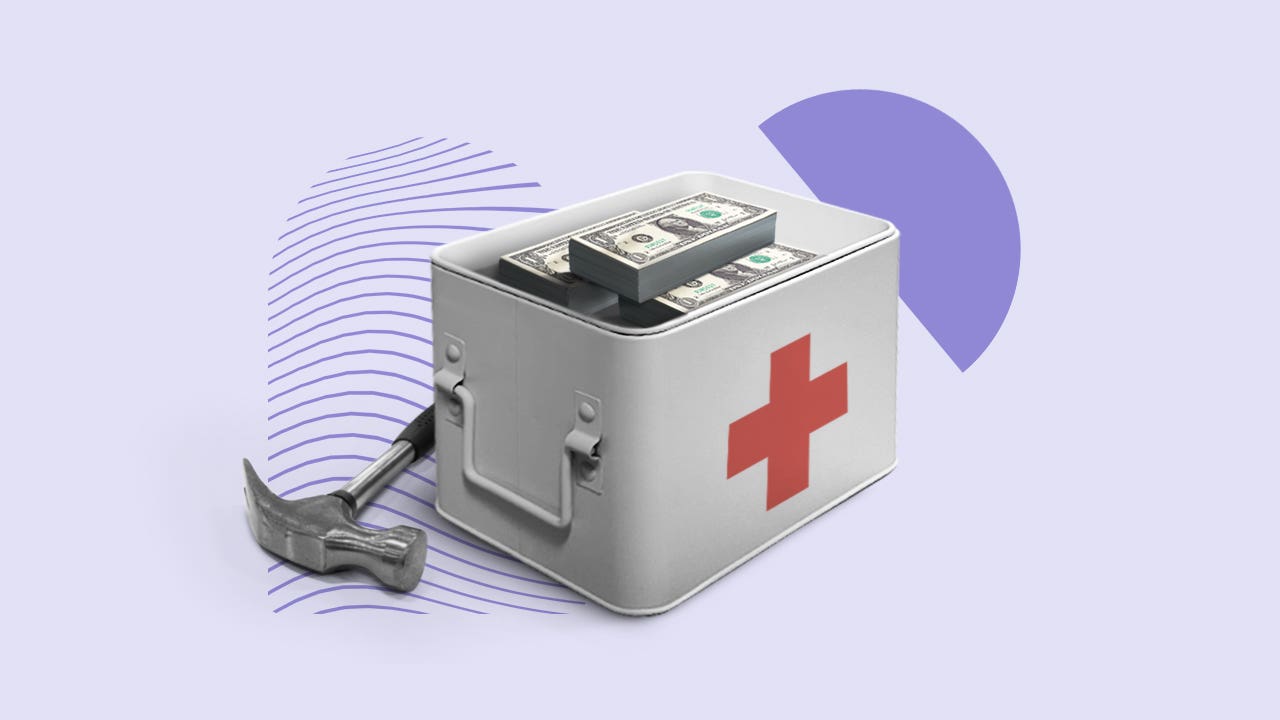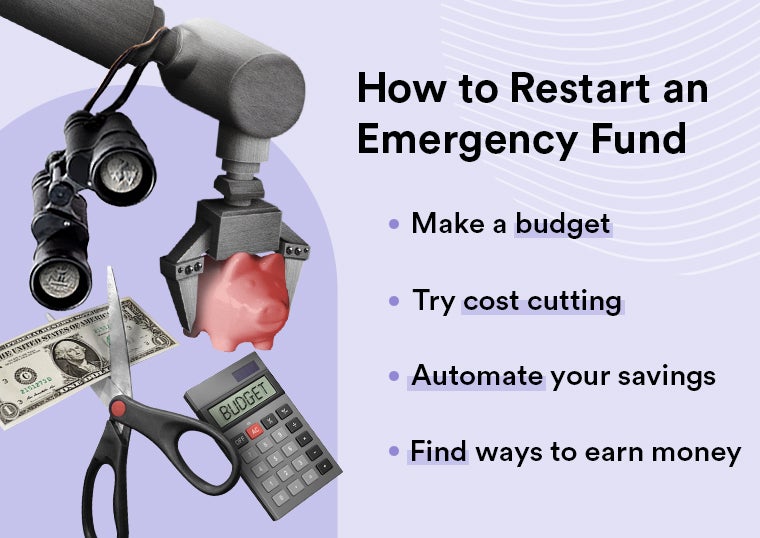How to rebuild your emergency savings

The Bankrate promise
At Bankrate we strive to help you make smarter financial decisions. While we adhere to strict , this post may contain references to products from our partners. Here's an explanation for .
The annual inflation rate in the U.S. has been easing steadily from its record peak of 9.1 percent in summer of 2022, with the latest rate of 3.1 percent for the 12 months ended November 2023. However, prices remain high on many essentials such as food, shelter and transportation.
With the higher cost of living, many Americans have had to dip into their emergency funds just to get by. Having at least three to six months’ worth of living expenses in the bank can help you get through the unexpected, such as a medical bill, a car repair or a job loss.
However, 70 percent of households didn’t increase their savings between 2023 and 2024, according to Bankrate’s emergency savings report.
Key emergency fund statistics
- Nearly one-third of Americans (31 percent) who feel behind in their emergency savings say it will take them 1-3 years to feel on track. (Bankrate emergency savings survey)
- Nearly two-thirds of Americans (62 percent) have either the same amount or less emergency savings than they did at the start of 2023. (Bankrate emergency savings survey)
- Nearly two-thirds (63 percent) of those who have not increased their emergency savings since the start of the year cite inflation as a reason. (Bankrate emergency savings survey)
- Saving for emergencies was identified by 15 percent of Americans as a main financial goal for 2023. (Bankrate personal finances outlook survey)
- More than 1 in 3 Americans (36 percent) have more credit card debt than emergency savings (the highest on record since 2011 polling). (Bankrate emergency savings report)
What is an emergency fund?
An emergency fund is money in the bank for the purpose of covering unplanned expenses. It can be your lifeline when faced with surprise home repairs, a big medical bill or a death in the family.
If you’re faced with a sudden job loss, an emergency fund should be able to cover several months of living expenses. These include your rent or mortgage payment, utility bills, food, insurance premiums and transportation.
A healthy emergency fund helps you avoid taking out loans or racking up high-interest credit card debt.
Just 44 percent of Americans say they have enough emergency savings to cover at least three months’ worth of expenses, Bankrate’s annual emergency savings report found. According to Bankrate’s financial wellness survey, among those who say money has a negative impact on their mental health, 56 percent say not having enough emergency savings is to blame.
How much should I save in my emergency fund?
Experts suggest stashing away at least three to six months’ worth of household expenses in an emergency fund.
“That sounds like a lot — and it is — but getting to that goal is a process,” says Amy Maliga, a financial educator with Take Charge America, a Phoenix-based nonprofit credit counseling agency. “If you’re starting from scratch, we recommend an initial savings goal of $500, which is enough to cover many common, smaller emergencies. Once you hit the $500 mark, keep going. Remember, the point of emergency savings is to stay out of debt by avoiding the need to use credit cards for unexpected expenses.”
In fact, 88 percent of people in 2023, say they wouldn’t be comfortable with their level of emergency savings until they’re able to cover at least three months’ worth of living expenses, Bankrate’s emergency savings report found. What’s more, 14 percent of Americans regret not saving enough for emergency expenses, according to Bankrate’s financial regrets survey.
Here is an example of what one month’s worth of household living expenses might look like:
- Rent: $2,084
- Utilities: $329
- Food: $779
- Car payment: $667
The total for the above expenses is $3,859. A three-month emergency fund for this example would contain $11,577, while a six-month emergency fund would hold $23,154.
Those who are self-employed may want to save more than three to six months’ worth of expenses to cover times when income fluctuates. Retirees whose income is generated from investment accounts would also benefit from extra savings, as would people with medical issues whose insurance might not fully cover things like surgeries or medications.
Setting aside additional funds could also provide peace of mind for anyone during hard times such as a pandemic or a recession.
Best savings account for an emergency fund
When it comes time to start putting money into an emergency fund, look for a high-yield savings account with few or no fees. High-yield savings accounts are liquid, which means you can quickly access your money when it’s needed.
A money market account that pays a competitive yield could be another good spot for your emergency savings. On the other hand, a certificate of deposit (CD) is not the best place for money you might need in a pinch, since CDs typically lock in your money for a set term. Taking the money out before a CD expires may result in a hefty early withdrawal penalty.
“While it’s great to earn interest on your emergency fund, your primary goal should be to keep the money safe and liquid,” says Scott Schleicher, a senior financial advisor at Empower. “Some accounts will have withdrawal limits, restrictions or even hidden bank fees, so just make sure you’re aware of that before moving your money.”
How to restart an emergency fund
Getting back on track with your emergency fund starts with identifying the amount of money you earn and spend each month. Creating a budget, cutting expenses, automating your savings and increasing your income are ways you can ultimately build up your emergency fund.

1. Make a budget
List where your money is going, including line items for things like housing, transportation, food, clothing, entertainment and so on. Making a list will help you identify how much you can add to your savings each month, so a line item for your emergency fund should be included. Determine your emergency fund goal, whether it’s three to six months’ worth of expenses or more.
If you already have a budget document in place, it’s good to reevaluate it periodically, as income and expenses can change over time.
Bankrate’s Home Budget calculator or a budgeting app can make this seemingly daunting process easier by helping you keep track of your spending.
2. Try cost cutting
One way to help save for emergencies is to streamline your expenses. This can help keep you from going into debt should unexpected expenses arise. In fact, of those with credit card debt, 43 percent say unexpected or emergency expenses are the main reason for it, Bankrate’s credit card debt survey found.
One way to cut costs is to identify unnecessary expenses, which could include frequent dining out or coffee runs, unneeded insurance, or unused subscriptions to magazines or streaming services.
“Analyze your monthly spending and find things you want to cut back on,” says Davon Barrett, banker and vice president at J.P. Morgan Private Bank. “Too much delivery? Big cellphone, Wi-Fi and cable bills? These expenses are all somewhat easy to reduce or find alternatives for once you’re aware of them.”
In addition to trimming expenses, one way to increase your savings is earning rewards from a credit card. This could be done in a healthy way by putting monthly household expenses or other planned purchases on a credit card.
Types of rewards you can earn with a credit card include cash back rewards and travel points or miles. Whatever rewards you earn, it’s important to only charge things you can pay off when the bill comes. Otherwise, you’ll be hit with interest charges, which can lead to even more expenses each month.
3. Automate your savings
One way to make saving money easier is to set up regular automatic transfers to the savings account that holds your emergency fund. This can often be set up easily using a mobile banking app.
You can also set up an automatic transfer of funds from checking to savings each month.
With economic uncertainty running high and a possible recession on the horizon, you’ll sleep better at night the more emergency savings you have tucked away.— Greg McBride, CFA | Bankrate chief financial analyst
4. Find ways to earn money
In addition to cutting costs, a way to supplement your main source of income is by getting a side hustle. This extra money can be put toward savings, or it can help you handle the increased cost of living due to inflation.
“For example, some people sell unneeded items online or hold a yard sale,” says Sean Fox, chief revenue officer at personal finance company Achieve. “Other people have part-time jobs, provide dog walking services, do yard work, tutor or help with IT services.”
Examples of side hustles include:
- Freelance writing
- Driving for Uber or Lyft
- Food delivery
- Babysitting
- Pet sitting
- Getting a roommate
Side hustle statistics
- Nearly 2 in 5 of Americans (39 percent) have a side hustle to build additional income (Bankrate’s side hustle survey)
- One-quarter (25 percent) of those who have a side hustle use it for savings, while 33 percent use it for regular living expenses (Bankrate’s side hustle survey)
- Over 2 and 5 Amercians with a side hustle expect to always need one (Bankrate’s side hustle survey).
Frequently asked questions
-
An emergency fund is money in the bank that’s earmarked for unplanned expenses such as a trip to the emergency room, a major home repair or a sudden job loss. Having such a fund lowers the chance you’ll need to go into credit card debt or borrow money elsewhere for such expenses.
-
Experts recommend you have at least three to six months’ worth of living expenses set aside in your emergency fund. Such expenses often include rent or mortgage, utilities, transportation and food, as well as payments toward your credit card or other loans.
-
An emergency fund is best kept in a liquid account you’ll have easy access to, such as a high-yield savings account or a money market account. Such a liquid account earns you some interest and allows you to withdraw the money easily and without paying a penalty. With stocks or bonds, there’s a greater risk of losing the money, and CDs often charge a high penalty if you need access to the funds before their term is up.
Related Articles



